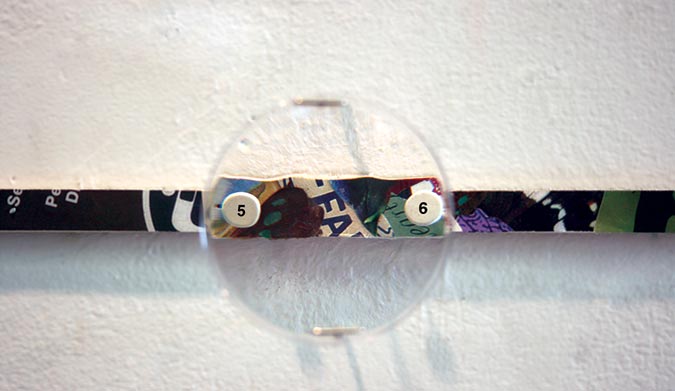Next story: Life As Art: The Art Monastery Project Fundraiser Event
The Things We Keep: MacKrell Collage Archive Project
by Lucy Yau
Continuum: MacKrell Collage Archive Project, curated by Gerald Mead
When someone you know passes on, you may be left with the task of sorting through their items. Figuring out what to keep and what to discard becomes a ritual of mourning. You may discover things about the person and so come to know that person better.
Through these odds and ends you come across the important but banal—bank statements, bills, insurance policies. Sometimes you may uncover odd facets of a personality: the relative with a fixation on songbirds, the hoarder of collectible snow globes, or, if you’re lucky, the baseball fan with the stash of valuable cards.
You may unearth a dusty journal full of long forgotten memories, petty grievances, ancient worries; love letters never sent, filled with discarded dreams, unrequited desires.
Such was the case when Marie MacKrell gifted her paper ephemera to artist Gerald Mead. MacKrell was a Buffalo native whose work won awards given by the Buffalo Evening News, Williamsville Art Society, Goldome Bank, and New York State Beer Wholesalers Association. She taught art classes to children and worked in various media: painting and photography, transitioning to assemblage. Over the course of her life she had gathered a vast collection of images from various sources: magazines, newspapers, personal effects, books, posters. These clippings and cards were organized into 30 categories stored in 16-by-20-inch Kodak photo paper boxes. A month after giving Mead her material, MacKrell passed away at the age of 95.

MacKrell gave Mead her collection so that another collage artist could make use of images she found fascinating. “This is a chance for the public to understand what was personal and germane to her,” Mead says. “She wanted these images to inspire and be used by future artists, for them to ruminate on and let things percolate.”
Every day until the end of the exhibition, a different box will be opened for the public to view.
Going through MacKrell’s belongings has a voyeuristic and archaeological quality. We discover on an index card she helpfully typed out that her artwork was influenced by Kurt Schwitters, Max Ernst, Joseph Cornell, Marchel Duchamp, and Robert Rauschenberg. Mixed in are highly personal documents such as birth announcements and papers for funeral arrangements. We also find that she was an Aquarius; kept old Christmas cards and her childhood Valentines, some exquisitely hand-cut dating to the 1910s; had a penchant for New Yorker cartoons, crushes on mid-20th-century movie stars and subscriptions to many magazines. Pre-Internet, this was how she filled her mind with vast stores of imagery.
Mead has used material from MacKrell’s archive in five other projects. For this exhibit, Mead has incorporated portions of the collection into his own art assemblage, which spans 207 feet of the gallery in the form of a half-inch strip. The effect is that of Mead taking pieces of these images and using a buzz-saw to slice through the collection, giving us glimpses of what captivated MacKrell. The snippets are surprisingly recognizable. Here we see a lock of hair from Botticelli’s Venus, a metonym for the entire painting, The Birth of Venus. Nearby is a fragment of Snoopy. On a far wall, if you look closely, is Spiderman.
MacKrell had an eclectic and at times bizarre taxonomy. Some of her categories are self-explanatory: flowers, children, dancers, animals. Others are more puzzling: clocks/legs/hands/eyes in the same box; or faces/financial; and, strangest yet, nude/mother/elderly, a box filled with maternal and matronly images among medically graphic obstetrics illustrations and gynecology ads. Mead has attempted to make the changeovers from disparate categories seamless, to avoid a collision of themes. An easy transition occurs from “Architecture” to “Buffalo” through recognizable bits of buildings. More difficult is the shift from “Humor” to “Memoriam.” Mead ingeniously uses an image of the drama masks of laughter and sadness for that particular change. At every intersection of subject matter he has placed magnifying glasses so one can inspect the work closely.
What elevates the MacKrell material beyond a jumbled set of files for scrapbooking is the meticulous manner in which Mead has handled, examined, and inventoried the items. The boxes have their own vocabulary, and Mead has devised his own classification system so that the public may better sift through the receipts, stamps, stencils, wallpaper, brochures, programs, cards, etc. Included in the exhibition with the archive are snapshots Mead took of each opened box. These photographs serve as collages onto themselves.
Mead also demonstrates his curatorial skills by including in the show works by other collage artists, chronologically placed. These companion pieces are by regional and international artists such as Charles Clough and Andrew Topolski, whose assemblages show alongside a composition by MacKrell called A Bit of City Whimsy. In contrast to the minute size of the strip, John Hultberg’s aptly titled Giant Collage is more than eight feet wide.
“This has been a wonderful opportunity for me to merge my skills as a curator, artist and collector and to tell stories with the collection,” Mead says.
Continuum is on view at the UB Anderson Gallery, Martha Jackson Place, until June 1 (829-3754 / ubartgalleries.buffalo.edu). Viewers of MacKrell’s archive will receive a signed and numbered examination certificate.
—lucy yau
blog comments powered by Disqus|
Issue Navigation> Issue Index > v7n20: Dig The Tomato Man (5/15/08) > Artshorts > The Things We Keep: MacKrell Collage Archive Project This Week's Issue • Artvoice Daily • Artvoice TV • Events Calendar • Classifieds |









 Current Issue
Current Issue